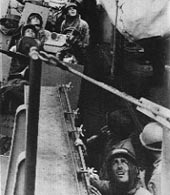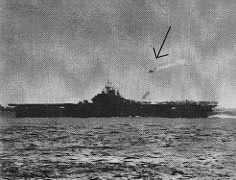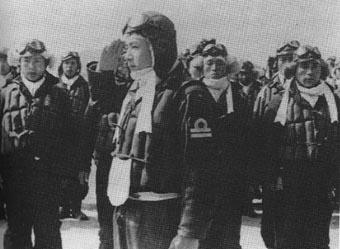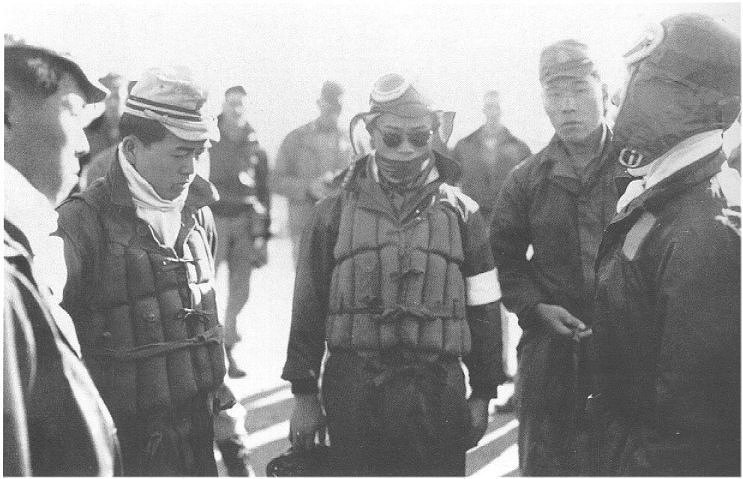By the fall of 1944, it had become clear that the Japanese were again
losing in a struggle for their empire. This time however, they were losing
to the American and Allied forces in the Pacific Theater of World War II.
Short on resources as well as victories, the Japanese again turned to this
“divine” force in the belief that it would again save them from total annihilation
by foreign forces. Only this time, instead of it being a “divine wind,”
it came in the form of men who were willing to sacrifice their lives in
order to help their country. These suicide pilots took on the name “kamikaze”
and applied it to their airborne missions.
 In
October, 1944, after receiving approval from the Minister of the Japanese
Navy, Admiral Takijiro Onishi, established the first Kamikaze group. By
organizing this first “Tokkatai” (beautiful death) force, as it is known
in Japan, Admiral Onishi believed that though the mission might not be
tactically effective, it would definitely be a powerful statement that
would show the world the true dedication to the Japanese cause of winning
the war. Admiral Onishi once said, “if they (the young pilots) are on land,
they would be bombed down, and if they are in the air, they would be shot
down. That’s sad…Too sad…To let the young men die beautifully, that’s what
‘Tokko’ is. To give beautiful death, that’s called sympathy” (Sasaki). In
October, 1944, after receiving approval from the Minister of the Japanese
Navy, Admiral Takijiro Onishi, established the first Kamikaze group. By
organizing this first “Tokkatai” (beautiful death) force, as it is known
in Japan, Admiral Onishi believed that though the mission might not be
tactically effective, it would definitely be a powerful statement that
would show the world the true dedication to the Japanese cause of winning
the war. Admiral Onishi once said, “if they (the young pilots) are on land,
they would be bombed down, and if they are in the air, they would be shot
down. That’s sad…Too sad…To let the young men die beautifully, that’s what
‘Tokko’ is. To give beautiful death, that’s called sympathy” (Sasaki).
 On October
21, 1944, the first organized suicide attack plan was created (Sasaki).
A squadron of 26 fighters called the “Shinpu Tokubetsu Kogekitai” would
carry it out from Mabalacat on the island of Luzon, in the Philippines
(Sasaki, Inoguchi 3). Shinpu is another way of reading the word Kamikaze
and Tokubetsu Kogekitai was the general name for the Japanese Imperial
Army and Navy (Inoguchi 12, Sasaki). In the plan, the pilots would fly
Japanese planes called Zeroes, each fitted with a 550-pound bomb, and intentionally
crash into their specified military target. It was the belief that a purposeful
and planned crash would “inflict more damage on the target than the fire
of 10 machine guns” (Information on the Kamikaze). Naoshi Kanno, a graduate
of the Naval Academy, was originally chosen to lead this mission. However,
due to the fact that he was away on the mainland of Japan at the time on
a different mission, Captain Yukio Seki was chosen to take his place.
Of the 26 planes in this original Kamikaze outfit, 13 of these planes were
used as an escort and the other 13 were divided into four attack groups.
These groups were given names from a nationalistic waka (poem) by Norinaga
Motoori of the Tokagowa Period. He wrote, On October
21, 1944, the first organized suicide attack plan was created (Sasaki).
A squadron of 26 fighters called the “Shinpu Tokubetsu Kogekitai” would
carry it out from Mabalacat on the island of Luzon, in the Philippines
(Sasaki, Inoguchi 3). Shinpu is another way of reading the word Kamikaze
and Tokubetsu Kogekitai was the general name for the Japanese Imperial
Army and Navy (Inoguchi 12, Sasaki). In the plan, the pilots would fly
Japanese planes called Zeroes, each fitted with a 550-pound bomb, and intentionally
crash into their specified military target. It was the belief that a purposeful
and planned crash would “inflict more damage on the target than the fire
of 10 machine guns” (Information on the Kamikaze). Naoshi Kanno, a graduate
of the Naval Academy, was originally chosen to lead this mission. However,
due to the fact that he was away on the mainland of Japan at the time on
a different mission, Captain Yukio Seki was chosen to take his place.
Of the 26 planes in this original Kamikaze outfit, 13 of these planes were
used as an escort and the other 13 were divided into four attack groups.
These groups were given names from a nationalistic waka (poem) by Norinaga
Motoori of the Tokagowa Period. He wrote,
“Shikishima no Yamato-gokoro wo hito towaba
Asahi ni niou Yamazakura-bana,” (The Japanese spirit is like mountain cherry
blossoms, radiant in the morning sun.) (Divine Wind 21).
Each of the groups was given part of the poem as a name: Shikishima
(a poetic name for Japan), Yamato (the ancient name for Japan), Asahi (morning
sun), and Yamazakura (mountain cherry blossoms) (Inoguchi 13, Sasaki).
On October 25, 1944, during the battle of Samos, the first ever Kamikaze
attack was carried out in which the 26 suicide pilots attacked the Saint
Lo, an American aircraft carrier and sank it (Millot 51-52).
 As a result
of early success, the Japanese extended their use of Kamikaze fighters.
In April, 1945 alone, it is estimated that these Kamikaze pilots, under
the command of Admiral Soema Toyoda launched over 1,400 missions and sunk
26 enemy ships during Operation Ten-Go. Another 2,000 missions were launched
against American fleets at Okinawa between April and July, 1945. However,
the damage became more and more minimal for over time, the U.S. Navy began
to learn how to deal with and prevent these attacks (E-teach). As a result
of early success, the Japanese extended their use of Kamikaze fighters.
In April, 1945 alone, it is estimated that these Kamikaze pilots, under
the command of Admiral Soema Toyoda launched over 1,400 missions and sunk
26 enemy ships during Operation Ten-Go. Another 2,000 missions were launched
against American fleets at Okinawa between April and July, 1945. However,
the damage became more and more minimal for over time, the U.S. Navy began
to learn how to deal with and prevent these attacks (E-teach).
The reasons for one becoming a Kamikaze pilot stem from the Japanese
heritage. From the time that they were young, Japanese children were taught
(some call it brainwashed) to accept the fact that their lives belonged
to the Emperor. As a result, in the public schools of Japan, children were
taught that “dying for the Emperor was the right thing to do and that,
those who do, will be worshipped” after death at the “Yakusuni Shrine”
(Moston). This lead to the Japanese motto of “jusshi reisho,” (sacrifice
life) being taught around Japan (Moston). This, along with the fact that
the Japanese military heavily censored military information about defeats,
led to the belief that if one were to become a kamikaze pilot, he would
be sacrificing his life for Japan’s ultimate victory (Moston).
The Bushido Code of the Samurai also played into the ideals of the kamikaze.
Warriors in Japan, since the time of the Samurai, viewed death as merely
a part of life. They, like the Kamikaze, conditioned themselves to accept
death, not fear it (Moston). Much like their Samurai predecessors, the
Kamikaze resigned themselves to death, and were calm in the face of it.
They, like the Samurai wore a Hachimaki, the Samurai headband made of a
folded piece of white cloth. This seemingly insignificant garment meant
much to both the Samurai and the Kamikaze pilots for it symbolized courage
and calm “in pre-battle composure” (Inoguchi 12.1, Kamikaze Pilots). The
fact that the Kamikaze pilots would volunteer for such missions showed
that they would rather die than be defeated. In dying, they, like the Samurai,
would bring honor to themselves, to their family, and to their country.
I n
order to be chosen for such an “honor,” a pilot had to first fill out an
application. Pilots chosen were usually uneducated men and were the second
or third sons of a family. It was the belief that the educated men were
needed to win the war and could not be sacrificed. Also, the first born
son was rarely chosen because they were to inherit the family business
and thus could not be sacrificed. Once chosen, the Kamikaze pilots were
made to accept a 5 point oath: 1) A soldier must make loyalty his obligation,
2) A soldier must make propriety his way of life, 3) A soldier must highly
esteem military valor, 4) A soldier must have a high regard for righteousness,
and 5) A soldier must live a simple life (Information on the Kamikaze). n
order to be chosen for such an “honor,” a pilot had to first fill out an
application. Pilots chosen were usually uneducated men and were the second
or third sons of a family. It was the belief that the educated men were
needed to win the war and could not be sacrificed. Also, the first born
son was rarely chosen because they were to inherit the family business
and thus could not be sacrificed. Once chosen, the Kamikaze pilots were
made to accept a 5 point oath: 1) A soldier must make loyalty his obligation,
2) A soldier must make propriety his way of life, 3) A soldier must highly
esteem military valor, 4) A soldier must have a high regard for righteousness,
and 5) A soldier must live a simple life (Information on the Kamikaze).
Prior to taking off, each pilot would write a farewell letter to his
family. It would be sent after there was confirmation of his death (Millot
68). One letter that a pilot wrote to his family stated,
"Please congratulate me! I have been
given a splendid opportunity to die. This is my last day. The destiny of
our homeland hinges on the decisive battle in the seas in the south where
I shall fall like a blossom from a radiant cherry tree. We are 16 warriors
manning the bombers. May our deaths be as sudden and clean as the shattering
of crystal!" (Kamikaze Pilots)
Many letters like this one were sent, along with hair or fingernail clippings,
by pilots to their relatives. Letters like this demonstrate how deeply
these pilots believed in their cause, and why it was such an honor for
them to be able to sacrifice themselves to help further it. These pilots
felt that they were doing the right thing. “To refuse such and honor” would
go against everything in their culture at the time (Moston).
Even with the knowledge that they would not ever return from their mission,
an astounding number of young men volunteered. In fact, three times as
many men applied for the missions, as there were planes (Information on
the Kamikaze). Most often, the more experienced pilots were turned down
due to the plain fact that their skill and knowledge would be needed for
both air-combat and to train younger, less experienced pilots to “fly to
their deaths” (Information on the Kamikaze). As a result, most of the kamikaze
pilots were young men, barely out of their teens, most of who saw this
opportunity as a chance to prove that they were “real men” (Information
on the Kamikaze). The youngest of these pilots was barely 17 years old,
and most were in their late teens and early twenties (Sasaki). As the battles
worsened, the average age of these pilots got younger and younger (Sasaki).
|

 In
October, 1944, after receiving approval from the Minister of the Japanese
Navy, Admiral Takijiro Onishi, established the first Kamikaze group. By
organizing this first “Tokkatai” (beautiful death) force, as it is known
in Japan, Admiral Onishi believed that though the mission might not be
tactically effective, it would definitely be a powerful statement that
would show the world the true dedication to the Japanese cause of winning
the war. Admiral Onishi once said, “if they (the young pilots) are on land,
they would be bombed down, and if they are in the air, they would be shot
down. That’s sad…Too sad…To let the young men die beautifully, that’s what
‘Tokko’ is. To give beautiful death, that’s called sympathy” (Sasaki).
In
October, 1944, after receiving approval from the Minister of the Japanese
Navy, Admiral Takijiro Onishi, established the first Kamikaze group. By
organizing this first “Tokkatai” (beautiful death) force, as it is known
in Japan, Admiral Onishi believed that though the mission might not be
tactically effective, it would definitely be a powerful statement that
would show the world the true dedication to the Japanese cause of winning
the war. Admiral Onishi once said, “if they (the young pilots) are on land,
they would be bombed down, and if they are in the air, they would be shot
down. That’s sad…Too sad…To let the young men die beautifully, that’s what
‘Tokko’ is. To give beautiful death, that’s called sympathy” (Sasaki).
 On October
21, 1944, the first organized suicide attack plan was created (Sasaki).
A squadron of 26 fighters called the “Shinpu Tokubetsu Kogekitai” would
carry it out from Mabalacat on the island of Luzon, in the Philippines
(Sasaki, Inoguchi 3). Shinpu is another way of reading the word Kamikaze
and Tokubetsu Kogekitai was the general name for the Japanese Imperial
Army and Navy (Inoguchi 12, Sasaki). In the plan, the pilots would fly
Japanese planes called Zeroes, each fitted with a 550-pound bomb, and intentionally
crash into their specified military target. It was the belief that a purposeful
and planned crash would “inflict more damage on the target than the fire
of 10 machine guns” (Information on the Kamikaze). Naoshi Kanno, a graduate
of the Naval Academy, was originally chosen to lead this mission. However,
due to the fact that he was away on the mainland of Japan at the time on
a different mission, Captain Yukio Seki was chosen to take his place.
Of the 26 planes in this original Kamikaze outfit, 13 of these planes were
used as an escort and the other 13 were divided into four attack groups.
These groups were given names from a nationalistic waka (poem) by Norinaga
Motoori of the Tokagowa Period. He wrote,
On October
21, 1944, the first organized suicide attack plan was created (Sasaki).
A squadron of 26 fighters called the “Shinpu Tokubetsu Kogekitai” would
carry it out from Mabalacat on the island of Luzon, in the Philippines
(Sasaki, Inoguchi 3). Shinpu is another way of reading the word Kamikaze
and Tokubetsu Kogekitai was the general name for the Japanese Imperial
Army and Navy (Inoguchi 12, Sasaki). In the plan, the pilots would fly
Japanese planes called Zeroes, each fitted with a 550-pound bomb, and intentionally
crash into their specified military target. It was the belief that a purposeful
and planned crash would “inflict more damage on the target than the fire
of 10 machine guns” (Information on the Kamikaze). Naoshi Kanno, a graduate
of the Naval Academy, was originally chosen to lead this mission. However,
due to the fact that he was away on the mainland of Japan at the time on
a different mission, Captain Yukio Seki was chosen to take his place.
Of the 26 planes in this original Kamikaze outfit, 13 of these planes were
used as an escort and the other 13 were divided into four attack groups.
These groups were given names from a nationalistic waka (poem) by Norinaga
Motoori of the Tokagowa Period. He wrote,
 As a result
of early success, the Japanese extended their use of Kamikaze fighters.
In April, 1945 alone, it is estimated that these Kamikaze pilots, under
the command of Admiral Soema Toyoda launched over 1,400 missions and sunk
26 enemy ships during Operation Ten-Go. Another 2,000 missions were launched
against American fleets at Okinawa between April and July, 1945. However,
the damage became more and more minimal for over time, the U.S. Navy began
to learn how to deal with and prevent these attacks (E-teach).
As a result
of early success, the Japanese extended their use of Kamikaze fighters.
In April, 1945 alone, it is estimated that these Kamikaze pilots, under
the command of Admiral Soema Toyoda launched over 1,400 missions and sunk
26 enemy ships during Operation Ten-Go. Another 2,000 missions were launched
against American fleets at Okinawa between April and July, 1945. However,
the damage became more and more minimal for over time, the U.S. Navy began
to learn how to deal with and prevent these attacks (E-teach).
 n
order to be chosen for such an “honor,” a pilot had to first fill out an
application. Pilots chosen were usually uneducated men and were the second
or third sons of a family. It was the belief that the educated men were
needed to win the war and could not be sacrificed. Also, the first born
son was rarely chosen because they were to inherit the family business
and thus could not be sacrificed. Once chosen, the Kamikaze pilots were
made to accept a 5 point oath: 1) A soldier must make loyalty his obligation,
2) A soldier must make propriety his way of life, 3) A soldier must highly
esteem military valor, 4) A soldier must have a high regard for righteousness,
and 5) A soldier must live a simple life (Information on the Kamikaze).
n
order to be chosen for such an “honor,” a pilot had to first fill out an
application. Pilots chosen were usually uneducated men and were the second
or third sons of a family. It was the belief that the educated men were
needed to win the war and could not be sacrificed. Also, the first born
son was rarely chosen because they were to inherit the family business
and thus could not be sacrificed. Once chosen, the Kamikaze pilots were
made to accept a 5 point oath: 1) A soldier must make loyalty his obligation,
2) A soldier must make propriety his way of life, 3) A soldier must highly
esteem military valor, 4) A soldier must have a high regard for righteousness,
and 5) A soldier must live a simple life (Information on the Kamikaze).